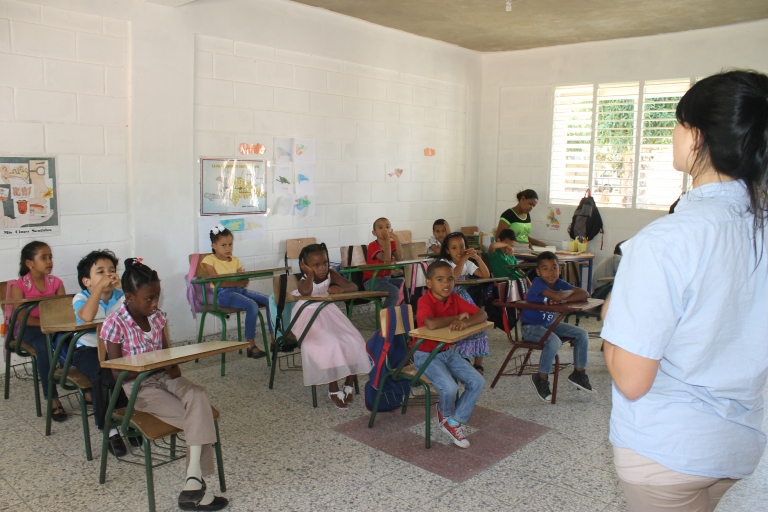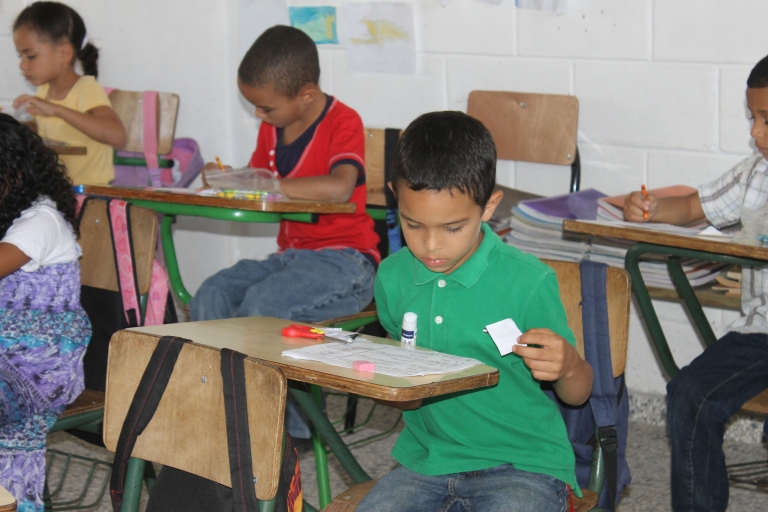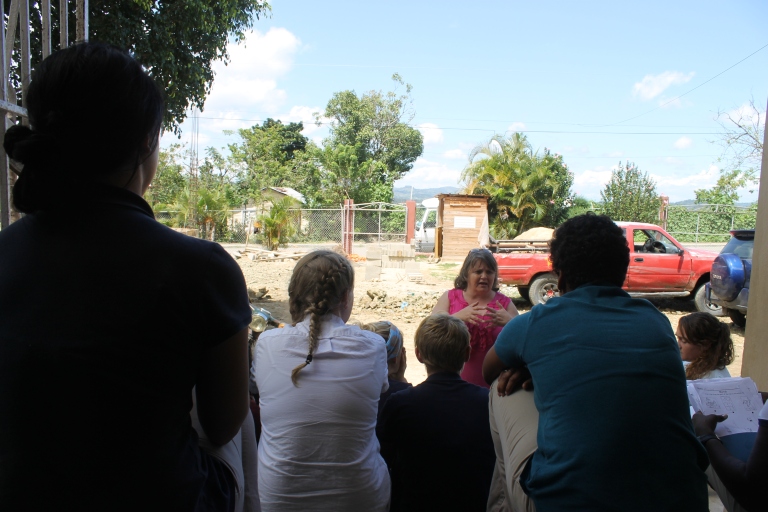“What exactly do you do as missionaries?” A common question we hear. In the past, we’ve given the easy answer. “Well, Andrew teaches high schoolers, mostly American ones.” While this satisfies the general question, it’s far from a complete answer. Hopefully, I can unveil a little more of the mystery surrounding what we do.
Each week, our students have what we call “community service projects.” Three times a week they go to a nearby community and serve. This service could be in the form of construction work, such as building or digging. It could be carrying supplies to a difficult-to-reach community. It could be visiting with nursing home residents. It could be teaching English.
The service projects that I want to highlight are the ones unique to our female students, ones in which I am involved. One day a week our students pile into a school van and ride five minutes to a nursing home. At this nursing home, they spend two hours. In the first hour, they interact with the residents. This involves talking to them (yes, in Spanish), playing a game or two with them, painting fingernails, and other craft type activities. The second hour is meal time for the residents. Some of the residents have no trouble feeding themselves, but there are a few who need help eating. Our students have stepped right up to this challenge. Some of them have told me that they feel extremely satisfied and useful when they help feed the residents. One student even told me that she would never have realized that she could work with this age group if it hadn’t been for this weekly visit.







Two times a week our female students teach English to Dominican students. In order to prepare for class, we meet one time a week. Before this meeting, I create curriculum and lesson plans for the girls to use. Their classes are at two different schools and are only forty-five minutes each time. This produces a bit of a challenge. How can we teach ESL (English as a Second Language) when we only see the Dominican students one time a week for a short class? We have discovered that focusing on one phrase a week, such as “I have,” and six vocabulary words that can be used in conjunction with the phrase works well. What you’ll see in the three following pictures are students prepping their materials for the classes they teach.



One of the schools our girls teach at is in the community of El Callejon. They teach 1st grade, 2nd grade, 3rd, grade, and 4th grade. The kids at this school are well behaved, and our general class schedule tends to be – songs, introduction of vocabulary, a vocabulary game, a couple of worksheets, and sticker time. Sticker charts and rewards are the methods our students use for discipline in the classroom. The next few photos will give you a peek into how the girls operate as teachers of their own classrooms.












The other school our students travel to once a week is in the community of Palo Blanco. This is a school run through another missionary organization called Kid’s Alive. Our students have found this school to be far more challenging than the one in El Callejon. Though both schools are located in poorer communities, Palo Blanco has a far rougher crowd. Our students often need reminded of why they serve at Palo Blanco and that they really are making a difference in the lives of their students.
At this school, our students teach 2nd and 3rd grade. Since the classes are large, we have our students split the classes in half and teach like there are four classes, instead of just two. Their class schedule varies a little from the class schedule at El Callejon. They start with songs, teach the vocabulary, and then move straight into worksheets. We found early on that, as a result of being a rougher crowd of students, any activity that allowed them to leave their chairs usually ended in chaos. Also, their discipline system is different at Palo Blanco. The students used the sticker chart system for a long time, but we have found that it isn’t as effective at Palo Blanco. Recently, we have tried the “star” system, which involves drawing stars on the board and erasing one each time the class or a student misbehaves. If there are any stars on the board at the end of class, the entire class earns a reward, such as a sucker.
The following pictures show you our students at work in Palo Blanco.













One other aspect of teaching at Palo Blanco is recess time. Our students teach 2nd and 3rd grade class at opposing times. While the 2nd grade teachers (meaning our students) are leading their classes, the 3rd grade teachers (again referring to our students) are playing with the kids who are outside for recess. These are kids who our students do not teach but simply have the opportunity to love on and play with – as you can see in the photo below.

Though this is only a peek into what our students accomplish through the week, I hope you begin to have a picture of what we do.


Thanks for the interesting Blog. Love you, Grandpa and Grandma
LikeLiked by 1 person
Thank you for being such an amazing example of love to these girls and for teaching them how to be selfless in service.
I know it is a huge part of their process in healing. My child loves this part of her time there. It’s my favorite part of her letters!
LikeLike
I’m thankful that she enjoys it! 🙂
LikeLike
I’m so glad that your girls that you minister to are involved in community schools and teaching in them as well as being involved in the nursing home. I enjoyed this blog and the pictures. Thanks so much for serving there in the DR and all that you do in these teens lives as well as in the community! Love to you and your family! Terri Lowrance
LikeLike
Thank you! We are grateful that we have the opportunity to take part in all of this too. 🙂
LikeLike
Thanks for all the info about your ministry. The photos were interesting. Helps us as we pray for you and love you. Grandpa and Grandma in Mishawaka…..
LikeLike
You’re welcome! Thank you for the prayers . . . we need them. 🙂
LikeLike